| |
Glossary of Coral Reef Terminology - M
MAA (mycosporine-like amino acids) - MAAs are a family of compounds which act as nature’s sunscreen in the marine environment. Shallow-water environments of tropical coral reefs are characterized by high levels of ultraviolet-A and ultraviolet-B radiation. Corals have developed an efficient defence against the potential damage of long-term solar irradiation, which often includes the production of natural "sunscreen"-type UV-absorbing compounds and related antioxidants. These compounds in shallow-water corals were identified to be a group of mycosporine-like amino acids (MAAs) having absorption maxima in the range 310-360 nm. MAAs are assumed to be produced by the zooxanthellae in coral tissues, since their biosynthesis involves a biochemical pathway not found in invertebrates. The major distribution of MAAs, however, resides within the coral tissues, suggesting that the algal partner of the mutualistic relationship provides UV protection to the whole of the relationship via MAA translocation. MAAs have been identified in a number of taxonomically diverse organisms such as fungi, marine heterotrophic bacteria, cyanobacteria, eukaryotic algae, marine invertebrates, fishes,and a wide variety of other marine organisms |
MAC (Marine Aquarium Council) - an international, not-for-profit organization that brings marine aquarium animal collectors, exporters, importers and retailers together with aquarium keepers, public aquariums, conservation organizations, and government agencies. Its mission is to conserve coral reefs and other marine ecosystems by creating standards and certification for those engaged in the collection and care of ornamental marine life from reef to aquarium |
macerate - to disintegrate tissues by means of cutting, soaking or enzymatic action to obtain a cell dissociation |
macro - a text file containing a sequence of commands that can be executed as one command. |
macro lens - in photography, a lens with the ability to focus from infinity to extremely close, allowing it to capture images of very small objects in frame-filling, larger-than-life sizes |

Macroalgae are important habitat on temperate and northern reefs.
|
macroalgae - algae that project more than one centimeter above the substratum |
macrobenthos (macrofauna or macroflora) - benthic organisms (animals or plants) whose shortest dimension is greater than or equal to 0.5 mm |
macroevolution - evolution on the grand scale resulting in the origin of higher taxa |
macrofauna - animals large enough to be seen with the naked eye |
macrogamete - the larger of the two gamete types in a heterogametic organism. It is considered as the the female gamete |
macroinvertebrate - an invertebrate having a body length greater than 2 mm |
macromolecule - a large polymer, such as DNA, RNA, protein, lipid or polysaccharide, made up of thousands of atoms |
macronutrient - a nutrient, such as a nitrate or phosphate, that is required by plants in relatively large quantities in order to undergo photosynthesis and growth |
macrophage - an amoeboid cell capable of moving through tissues, engulfing and destroying dead cells or bacteria. Certain white blood cells are the most aggressive macrophages |
macrophotography - photography of a subject where the image is recorded in the same or larger than actual size; type of photography employing the use of special lenses or attachments allowing close-range photos of a given subject |
macrosmatic - pertains to animals with a well developed olfactory (smell) sense |
macrotidal - coastal ocean or waterway with a high mean tidal range e.g., greater than 4 meters |
macula - a dark spot, blemish; the small, highly sensitive area (of the human eye) which is located in the center of the retina. It is responsible for near and fine detail vision |
Madison/Swanson and Steamboat Lumps Marine Reserves - two protected areas in the Northeastern Gulf of mexico of slightly over 100 nautical square miles each, the Madison-Swanson (high relief area) and Steamboat Lumps (low relief area). Within each area, fishing is prohibited for all species except for highly migratory species. These marine reserves were created primarily to protect a portion of the gag grouper (Mycteroperca microlepis) spawning aggregations and to protect a portion of the offshore population of male gag. The areas are also suitable habitat and provide protection for many other species, such as scamp, red grouper, warsaw grouper, speckled hind, red snapper, red porgy, and others |

The white spot in the middle of the central disc of the starfish is the madreporite, the opening into the echinoderm+s water vascular system.
|
madreporite - a perforated platelike structure in most echinoderms that forms the intake for their water vascular systems |
magenta - reddish purple color |
magma - molten rock that forms naturally within the Earth. Magma may be either a liquid or a fluid mixture of liquid, crystals, and dissolved gases |
magmatic hotspot - in geology, a hotspot is a location on the Earth's surface that has had volcanism for a long period of time. Geologists have identified some 40-50 such hotspots |
magnetic north - the direction a compass needle points when there are no local interfering influences |
maillist (mailing list) - a system that allows people to send e-mail to one address, whereupon their message is copied and sent to all of the other subscribers to the maillist. In this way, people who have many different kinds of e-mail access can participate in discussions together |
maitotoxin - a neurotoxic compound which is produced by certain marine dinoglagellates and associated with the digestive tract of herbivorous fishes. It is responsible for a form of seafood poisoning in humans eating tropical coral reef fishes |
makatea - a fossil coral reef |
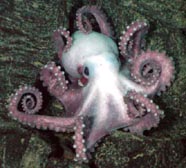
A Pacific octopus (Mollusca) photographed during the NOAA Submarine Ring of Fire expedition, 2002. (Photo: NOAA Ocean Explorer)
|
malacology - the scientific study of mollusks |
Malacostraca - a class of arthropods in the subphylum Crustacea. The more than 20,000 described species of Malacostraca can be divided into two groups, the Phyllocarida, and the Eumalacostraca. Phyllocarida contains the oldest crustacean known and includes only one living group.The Eumalacostraca consists of all Malacostracan groups other than the Phyllocarida. Eumalacostracans generally possess a well-developed carapace and a long, muscular abdomen. It is the group that contains most of the animals the general public recognize as crustaceans, such as shrimp, crabs, lobsters |
malar - pertaining to the cheek region of vertebrates |
Malesia - a biogeographical region that includes the Malay Peninsula, Indonesia, the Philippines and New Guinea, based on a shared tropical flora derived mostly from Asia but also with numerous elements of the Antarctic flora |
Malesian floral subkingdom - a botanical subkingdom of the Paleotropical Kingdom which encompasses the islands of Southeast Asia and the malay peninsula, extending as far east as New Guinea, the Solomon Islands and Vanatu |
Malthusian Law - when birth and death rates are constant, a population will grow (or decline) at an exponential rate |

Dolphins are among the most recognizable marine mammals; this one floats serenely in the Caribbean Sea. (Photo: Copyright Corel Corporation)
|
Mammalia - a class of warm blooded animals (mammals) whose common characteristics include the presence of hair, milk-secreting glands, a muscular diaphragm between the abdominal and pleural and mediastinal cavities, a lower jaw composed of a single pair of bones, a middle ear containing three bones, and the presence of only a left systemic arch |
mammalian dive reflex - the physiological responses, including bradycardia and shutdown of the peripheral circulation, which occurs during dives by an air-breathing vertebrate |
mammalogy - the scientific study of mammals |
mandible - pertains to mouth parts; the lower jaw |
mangal - relating to a shoreline ecosystem dominated by mangrove trees, with associated mud flats; collective term for a mangrove community |

Mangrove nursery area, Puerto Rico.
|
mangrove - a general name for several species of halophyte belonging to different families of plants (including trees, shrubs, a palm tree and a ground fern) occurring in intertidal zones of tropical and subtropical sheltered coastlines and exceeding one half meter in height. The term is applied to both the individual and the ecosystem, the latter of which is termed mangal. Mangroves provide protected nursery areas for juvenile reef fishes, crustaceans, and mollusks. They also provide a feeding ground for a multitude of marine species. Many organisms find shelter either in the roots or branches of mangroves. Mangrove branches are nesting areas for several species of coastal birds. The root systems harbor organisms that trap and cycle nutrients, organic materials and other important chemicals. Mangroves also contribute to higher water quality by stabilizing bottom sediments, filtering water and protecting shorelines from erosion. They protect reefs from land runoff sedimentation. Conversely, coral reefs protect mangroves and seagrasses from erosion during heavy storms and strong wave action |
manoalide - a marine pharmaceutical isolated from the marine Indopacific sponge Luffariella variabilis. It possesses analgesic and anti-inflammatory properties |
manta tow technique - a technique used to provide a general description of large areas of reef and to gauge broad changes in abundance and distribution of organisms on coral reefs. The technique, widely used in Australia, involves towing a snorkel diver (observer) at a constant speed behind a boat. The observer holds on to a 'manta board' attached to a small boat by a 17-meter length of rope. This person makes a visual assessment of specific variables during each manta tow (2 minutes duration), and records these data when the boat stops, on a data sheet attached to the manta board. The manta tow technique is used to provide a general description of large areas of reef and to gauge broad changes in abundance and distribution of organisms on coral reefs. The advantage of manta tow over other survey techniques is that it enables large areas of reefs to be surveyed quickly and with minimal equipment |
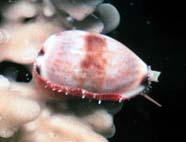
A cowrie, Cypraea sp., with partially extended mantle.
|
mantle - a membranous or muscular structure in mollusks that surrounds the visceral mass and secretes a shell if one is present |
mantle (geology) - the middle layer of the Earth, lying just below the crust and consisting of relatively dense rocks. The mantle is divided into the upper mantle and the lower mantle; the lower mantle has greater density than the upper mantle |
mantle cavity - the space between the mantle and the rest of the body parts of a mollusk, which contains several important respiratory and reproductive organs |
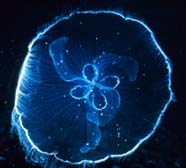
The mouth of a jellyfish is at the end of the manubrium, which extends to engulf prey. (Photo: NOAA/Florida Keys National Marine Sanctuaries)
|
manubrium - the proboscis of a jellyfish: a tubular structure that connects the mouth to the digestive cavity |
Manzamine A - a marine pharmaceutical, extracted from the marine sponge Xestospongia ashmorica, possessing anti-inflammatory, antimalarial, antifungal, and anti-HIV-1 activity. It is also active against the Gram-positive bacteria Bacillus subtilis and Staphylococcus aureus |
marae - in the Marquesas, a Polynesian sacred enclosure or a place of worship . In Hawaii, it is called a "heiau" |
MAREANO - a Norwegian program to survey and perform basic studies of the seabed’s physical, biological, and chemical environment and to systematize the information in a marine area database that will cover Norway’s coastal and marine region |
mareogram - a graphic representation of the rise and fall of the sea level, with time as abscissa and height as ordinate, usually used to measured tides; may also show tsunamis; also called 'marigram' |
MAREPAC (Marine Resources Pacific Consortium) - MAREPAC is a consortium made up of representatives from nine islands in Micronesia (Marshall Islands, Federated States of Micronesia, Northern Marianas, Guam, Palau, and American Samoa). MAREPAC's mission is to develop regional capabilities, foster collaboration, and disseminate accurate information in support of sound policy development on sustainable use of marine resources of cultural, economic, and scientific value |
margin - a boundary, edge, or border of a structure |
Marianas Archipelago Reef Assessment and Monitoring Program (MARAMP) - a multi-agency effort that began in 2003 with the first cruise to the Mariana Archipelago. The objective of MARAMP is to rapidly evaluate and map the shallow water reef habitats in the Mariana Archipelago. Scientists on board the National Oceanographic and Atmospheric Administration (NOAA) research vessel Oscar Elton Sette use a variety of techniques to study the oceanography and coral, fish, algae, and benthic habitats around most of the islands and offshore banks of the archipelago |

Shrimp farms and their waste runoff have resulted in the destruction of coastal habitats and added to pollution in critical�estuarine waters.
|
mariculture - the cultivation of marine organisms under controlled conditions; a synonym for marine aquaculture |
marine - an umbrella term for things relating to the ocean, coastal zones, and tidal areas |
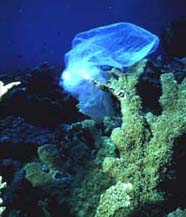
Marine debris, such as this plasic bag, can kill coral. (Photo: NOAA)
|
marine debris - debris composed primarily of plastics, nets, lines, other fishing gear, glass, rubber, metal, wood and cloth. Sources of debris are people on beaches, storm drains, fishing boats, waste treatment sites, and industrial facilities. These materials have damaging effects on coral reefs |
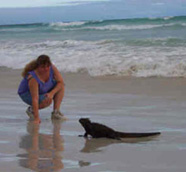
A marine iguana from the Galapagos Islands. (Photo: NOAA)
|
marine iguana - the marine iguana (Amblyrhynchus cristatus) inhabits the Galapagos Island, an archipelago on the Equator, 800 kilometers west of the Ecuadorian coast. It differs from the mainland iguanas by the shape of the snout and other morphological features. The species probably rafted to the islands many millions of years ago, and developed a new ecological niche.They feed almost exclusively on marine algae and seaweed in the intertidal zone, and some make shallow dives past the breaker zone |
marine insects - insects account for over 75% of all species that have been described by science. Of these, only 3 percent are aquatic in any life stage. Even more rare are the 250 to 350 species (in several orders, the largest being the Diptera) in this aquatic grouping that have independently evolved adaptations to exposure to salt water. Marine insects include pelagic species, species inhabiting tide pools, and beach and marsh-dwelling species. Just five species of sea skaters (Halobates sp) are pelagic. Marine midges in the genus Pontomyia inhabit tide pools and lagoons in the Indo-Pacific. Some genera of rove beetles live in sand burrows in beach intertidal zones |
marine lake - a unique ecosystem which forms when a depression in a porous, calcareous landscape is flooded by rising sea-levels. Connected in various ways to the sea, they form a continuum from complete isolation to lagoon-like. Marine lakes, such as the famous ones of Palau, contain a variety of habitats which foster adaptive radiation and rapid evolution of the biological assemblages. Palau's Jellyfish Lake is perhaps the most famous of these marine lakes, containing an estimated number of 17 million jellyfish (Mastigias medusae) in January 2007. The greatest number (estimated) ever recorded was 31 million |
Marine Life Conservation District (MLCD) - in the state of Hawaii, a major type of Marine Protected Area (MPA) designed to conserve and replenish marine resources and usually allow only limited fishing and other consumptive uses. They provide fishes and other aquatic life with a protected area in which to grow and reproduce, and are home to a great variety of species. Fishes in most MLCDs are fairly tame and often show little fear of humans. MLCDs are most popular as sites for snorkeling, diving and underwater photography. MLCDs were introduced to Hawai'i in the fall of 1967 with Hanauma Bay on Oahu. The resulting increase in fish populations was phenomenal, and the bay has become world famous. At the present time there are ten MLCDs statewide |
Marine Managed Area (MMA) - see: Marine Protected Area |
marine pharmaceutical - a bioactive chemical derived from a marine organism which is used to treat disease and other medical conditions |
Marine Protected Area (MPA) - any area of the marine environment that has been reserved by federal, state, territorial, tribal or local laws or regulations to provide lasting protection to part or all of the natural or cultural resources within them. Familiar examples of U.S. MPAs include National parks, wildlife refuges, monuments and marine sanctuaries, fisheries closures, critical habitat, habitat areas of particular concern, state parks, conservation areas, estuarine reserves and preserves, and numerous others. Areas which are not MPAs are areas where access is restricted for reasons other than conservation (such as security zones, shellfish closures, sewage discharge areas, and pipeline and cable corridors), or unprotected areas that are logistically inaccessible due to weather, sea state, etc; MPAs are sometimes called Marine Managed Areas (MMA). However, "marine protected area" is a broad, inclusive term which includes both mulit-purpose sites with some restrictions as well as the more restrictive "no take marine reserves." |
Marine Protected Area (MPA) Classification System (U.S.) - the MPA Classification System uses five key functional characteristics to describe any MPA. Taken together, these characteristics influence the site’s effects on local ecosystems and human users, and thus its role in contributing to the conservation of healthy marine ecosystems: (1) Conservation Focus, (2) Level of Protection Afforded, (3) Permanence of Protection, (4) Constancy of Protection, and (5) Ecological Scale of Protection. For a detailed guide to the classification system, see "http://www.mpa.gov/pdf/helpful-resources/factsheets/final_class_system_1206.pdf |
Marine Protected areas (MPA) Network - a system of individual marine protected areas operating cooperatively and synergistically, at various spatial scales, and with a range of protection levels, in order to fulfill ecological aims more effectively and comprehensively than individual sites could alone. The system will also display social and economic benefits, although these may only become fully developed over long time frames |
marine reserve - an area in which some or all extractive activities are prohibited |
marine sanctuary - as defined by the U.S. government: Multiple-use marine protected areas, protected under the National Marine Sanctuaries Act, that may include breeding and feeding grounds of whales, sea lions, sharks, and sea turtles; significant coral reefs and kelp forest habitats; and the remains of historic shipwrecks. Some sanctuaries are zoned to include no-take areas. (Note: States may have sanctuaries that have a different purpose or are defined differently) |
marine snow - dense concentrations of particulate organic detritus and living organisms whose downward drift appears similar to a snowfall |
marine toxicology - a broad field of study encompassing the production, fate, and effects of natural and synthetic harmful chemical substances, such as pollutants, in the marine environment |
marine toxin - a variety of organic compounds containing nitrogen as part of a heterocyclic system have been isolated from marine animals. These compounds are mostly toxic |
maritime climate - a climate strongly influenced by an oceanic environment, found on islands and the windward shores of continents. It is characterized by small daily and yearly temperature ranges and high relative humidity |
marker gene - in genetic engineering, an easily identified gene that is inserted into an organism, along with a desired gene. The presence of the marker gene demonstrates that the transformation was successful |
marl - fine-grained carbonate-rich mud; a calcareous clay which contains approximately 30 to 65 percent calcium carbonate |
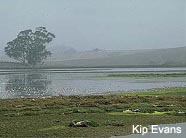
Coastal marsh in Monterey Bay National Marine Sanctuary, CA. (Photo: Kip Evans)
|
marsh - a soft, wet area periodically or continuously flooded to a shallow depth, usually characterized by a particular group of grasses, cattails and other low plants |
marsupium - an abdominal pouch where certain animals carry their young, as in some crustaceans and the brood pouch of the male seahorse |
Mascarene Plateau - a submerged volcanic plateau dominating the western Indian Ocean, extending approximately 2,000 km between Seychelles and Mauritius. It covers an area of over 115,000 square kilometers of shallow water with depths ranging from 8 m to 150 m on the plateau, plunging to depths of 4000 m at its edges. It is the major marine ecosystem of the western Indian Ocean |
mass coral bleaching - coral bleaching extending over large distances as a result of anomalously high water temperatures |
mass extinction - a catastrophic, widespread perturbation where major groups of species become extinct in a relatively short time |
mass spawning - spawning events where many different species spawn simultaneously |
mass spectrometer - a laboratory instrument that measures the mass-to-charge ratio of individual molecules that have been converted into ions. This information is then used to determine the masses of the molecules |
mass spectrometry - an analytical technique where ions are separated according to their ratio of charge to mass. The atomic weight of the particle can be obtained from the mass spectrum produced |
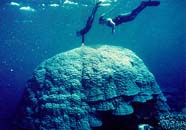
Scuba divers examine a massive coral colony. (Photo: Australian Institute of Marine Sciences)
|
massive - having a large compact structure without a definable shape |
massive colony - a coral colony that is solid and typically hemispherical in shape |
mat-forming algae - a complex of filamentous algae that binds either sand particles or muddy substrate |
maternal inheritence - uniparental inheritance in which all offspring have the genotype and phenotype of the female parent |
maternal mRNA - messenger RNA found in oocytes and early embryos that is derived from the maternal genome during oogenesis |
maxilla - pertains to mouth parts; the upper jaw |
maxilliped - one of the mouth appendages of crustaceans, situated behind the maxillae. Crabs have three pairs, but many of the lower crustaceans have only one pair |
maximal food chain - a sequence of species running from a basal plant or algal species to another species that feeds on it (a herbivore), and so on to a carnivorous climax predator |
maximum sustainable yield - the maximum number of a food or game population that can be harvested without harming the population's ability to grow back; the largest average catch or yield that can continuously be taken from a stock under existing environmental conditions |
mean - a statistical measure of central tendency. The sum of a set of observations divided by the number of observations. It is also referred to as 'arithmetic mean' and 'sample mean' |
mean high tide - the level to which the water rose on an average day over a previous period of time (years or decades); the average of all the high tides as calculated over a long period of time |
mean low tide - the average altitude of all low tides recorded at a given place over a long period of time |
mean sea level - the level of the surface of the sea between mean high and mean low tide. It is used as a reference point for measuring elevations |
meandroid colony - a massive colony that has corallite mouths aligned in valleys, such that there are no individual polyps |
meandroid form - a coral growth form in which the corallites are arranged in multiple series within the same walls |
mechanoreceptor - a neurological receptor that responds to mechanical energy, e.g. pressure, touch, and gravity |
median - a statistical measure of central tendency. The middle-most value in a set of observations with an equal number of observations lying above and below the median value |
median fin - in fishes, an unpaired fin located on the sagittal plane of the body, i.e., the dorsal, caudal and anal fins |
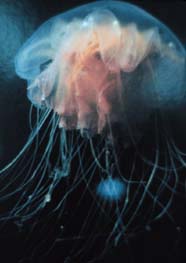
A jellyfish (medusa stage) showing its oral or subumbrella surface. The hanging tentacles bear stinging cells, used for food capture.
|
medusa - the free swimming stage of some corals, jellyfish, anemones, hydroids and comb jellies, shaped like a bell or umbrella and swims by pulsations of the body |
medusa bud - one of the buds of a hydroid, destined to develop into a gonophore or medusa. Medusa buds are released from the gonangium through a central opening, the gonopore |
medusoid - a body form resembling a medusa; umbrella shaped |
megabase (Mb) - unit of DNA or RNA sequence equal to one million (10) pairs of nucleotide bases. Abbreviated Mb |
megabyte (mb) - a measure of storage space. One megabyte roughly translates to a million characters of text, or 180,000 words |
megafauna - the largest size category of animals in a community |
megalops larva - the larval stage in brachyuran crabs that follows the zoea larval stage |
megasclere - a large spicule in sponges |
meio- - smaller; less than |
meiobenthos (meiofauna or meioflora) - benthic organisms whose shortest dimension is less than 0.5 mm but greater than or equal to 0.1 mm |
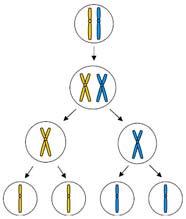
Diagram showing the meiotic division of a diploid cell, which in two divisions, results in the production of four haploid daughter cells. This process is also termed gametogenesis because it results in haploid sperm and egg cells.
|
meiosis - a two-stage type of cell division in sexually reproducing organisms that results in the development of sperm and egg cells . In meiosis, a diploid cell divides to produce four haploid cells, each with half the original chromosome content. In organisms with a diploid life cycle, the products of meiosis are called gametes. In organisms with an alternation of generations, the products of meiosis are called spores |
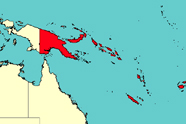
Map showing location of Melanesia. (Graphic: Melanesian Cultural Heritage Management Identification Study)
|
Melanesia - a large region of volcanic islands which includes New Guinea, the Solomon Islands, Vanuatu, Fiji, Maluku, the Torres Strait Islands, and New Caledonia. The name "Melanesia" means "black islands", referring to the dark-complexioned inhabitants these islands |
melanic - very dark or black color |
melanin - a pigment in the skin of animals which determines skin and coat color. It is found in two chemically different forms: eumelanin (which produces brown and black) and phaeomelanin (which produces yellow and red). Melanin also provides protection against the damaging effects of ultraviolet radiation |
melanistic - dark or blackish |
melanocyte - a cell in the inner layer of the epidermis that produce melanin |
melanophore - a chromatophore which contains black and brown pigments called melanin |
melon - a lens-shaped fatty deposit lying in the facial depression of many toothed whales, such as the bottle-nosed dolphin. It appears as the bulging forehead just in front of the blowhole. It contains fatty deposits, muscles, and nasal air sacs and passages. The melon is used in focusing a whale's sounds, functioning as an acoustical lens for echolocation.The fatty deposits change shape as the whale is producing sounds |
membrane filter - a thin microporous material of specific pore size used to filter bacteria, algae, and other very small particles from water |
Mendel's Laws of Heredity - the Law of Segregation states that each hereditary characteristic is controlled by two 'factors' (alleles), which segregate and pass into separate germ cells (gametes). The Law of Independent Assortment states that pairs of 'factors' segregate independently of each other when germ cells are formed |

Gregor Mendel (1822-1884), the "father" of the science of genetics.
|
Mendelian inheritance - one method in which genetic traits are passed from parents to offspring. It is named after the Austrian monk, Gregor Mendel, who first studied and recognized the existence of genes and this method of inheritance; a hereditary process explainable in terms of the behavior of chromosomes, e.g., segregation of chromosomes, independent assortment, and homologous exchange of parts |
Mendelian population - a natural, interbreeding unit of sexually reproducing organisms sharing a common gene pool |
menisciform - crescent-shaped |
meristem - organized, undifferentiated plant tissue with rapidly dividing cells (mitosis) that differentiate to form new tissues or organs; a specialized area within a plant where rapid cell division occurs, e.g., roots and shoots |
meristic - pertains to serially repeated structures which can be counted, e.g. scales, vertebrae, fin rays, fin spines, other spines, myomeres, photophores, scutes, laterel line pores, etc |
mermaid's purse - an egg case of a shark or ray, usually oblong in shape with horns or tendrils |
meroblastic cleavage - incomplete cleavage of the zygote, restricted to the blastodisc, the non-yolky cytoplasm at one end of the egg; typical of teloblastic eggs |
meroplankton - planktonic eggs and larvae which are temporary members of the plankton community |
merotrichous - pertaining to a nematocyst with spines confined to one distal region of its thread |
mesenchyme - in cnidarians, a primitive "connective tissue" located between the epidermis and the gastrodermis. If it contains no cell components, it is termed "mesoglea"; undifferentiated cells of an embryo, derived from mesoderm, which give rise to connective tissue and the circulatory and lymphatics systems; amoebocytic cells often embedded in a gelatinous matrix |
mesenteric filament - the cord of tissue In sea anemones that runs along the edge of incomplete mesenteries and which bear glandular cells and nematocysts; they are used in digestion and become acontia toward the pedal disc |
mesentery - a sheet of tissue that envelops, separates, or supports particular organs or body regions; a vertical sheet of tissue that divides the gastrovascular cavity of sea anemones |
mesentery, complete - in anthozoans, a mesentery which extends from the body wall to attach to the actinopharynx |
mesentery, directive - in anthozoans, one of a pair of mesenteries attached to the actinopharynx in which the mesogleal pleats of the retractor muscles face away from one another, toward the exocoel |
mesentery, incomplete - in anthozoans, a mesentery in which the inner edge does not extend to the actinopharynx |
mesentery, nondirective - in anthozoans, one of a pair of mesenteries attached to the actinopharynx in which the mesogleal pleats of the retractor muscles face each other, toward the endocoel |
meso- - a prefix meaning 'middle' |
Mesoamerican Reef - the largest coral reef system in the Atlantic Ocean and the second largest coral reef in the world. It extends nearly 700 miles from the northern tip of the Yucatan peninsula to the Bay Islands off the coast of Honduras |
mesocosm - an experimental apparatus or enclosure designed to approximate natural conditions, and in which environmental factors can be manipulated. Mesocosms characteristically include both natural species assemblages in addition to structured populations |
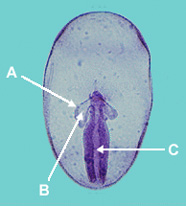
Late gastrula. This photograph is a dorsal view of the embryo, with the anterior being toward the animal pole and the posterior toward the vegetal pole. Note the beginning of the formation of enterocoelic (mesodermal) pouches, from which the mesoderm is derived, on the right and left side of the anterior end of the gastrocoel. A - mesoderm; B - coelom; C - archenteron (Photo: Cell and Developmental Biology Online website (University of Guelph) http://www.uoguelph.ca/zoology/devobio/)
|
mesoderm - the middle of the three germ layers of a triploblastic embryo that gives rise to the skeletal and support, muscular, blood vascular, urogenital and reproductive systems, and contributions to some glands |
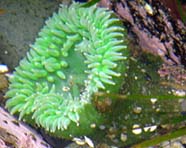
Inner tissues of this Giant Green Anemone (Anthopleura xanthogrammica) are separated by the mesoglea. (Photo: Lisa Eschenbach)
|
mesoglea - the connective tissue layer between the epidermis and gastrodermis of cnidarians and ctenophores (comb jellies) |
mesogleal pleat - in anthozoans, a sheet of longitudinal retractor muscles (myonemes) anchored to the mesoglea and pleated accordian-wise so that the mesoglea is sandwiched between two layers of epithelium within the middle portion of a mesentery |
mesohyle - the non-cellular gel layer (also called 'mesenchyme') of sponges. It is located between the epidermis (pinacoderm) and the choanoderm, the cell layer that lines the spongocoel. The mesohyle contains either spicules (supportive needles made of calcium carbonate) or spongin fibers (a flexible skeletal material made from protein); also called mesohyl |
mesolamella - a collagenous layer that separates the choanochambers of hexactinellid sponges (glass sponges) |
mesolecithal - a moderately telolecithal egg, typical of amphibians |
mesopelagic zone - a layer (zone) of the ocean which lies just below the epipelagic zone. It extends from 200-1000 meters. The mesopelagic zone is sometimes referred to as the twilight zone as sunlight this deep is very faint. This zone contains the thermocline, where temperature decreases rapidly with depth |
mesophotic coral ecosystem (MCE) - an ecosystem which occurs at intermediate depths (30-100 m) of the photic zone. Light-dependent (zooxanthellate) corals are present that typically are found along island and continental slopes as well as on top of sea mounts. MCEs are distinct from “true” deep water azooxanthellate coral ecosystems that occur at greater depths and are not light-dependent |
mesophotic zone - intermediate depths (typically 30-200 m) of the photic zone found in tropical and subtropical regions and characterized by the presence of light-dependent (zooxanthellate) corals and associated algal and sponge-dominated communities |
mesotidal - coastal ocean or waterway with a moderate mean tidal range, e.g., between 2 and 4 meters |
Mesozoic - an era of time during the Phanerozoic eon lasting from 245 million years ago to 66.4 million ago |
metabolic gas - a gas which is released by the body as a result of metabolism. Carbon dioxide is an example of a metabolic gas |
metabolic pathway - a set of oriented reactions interacting under given physiological conditions via simple or apparently simple intermediates. There are relatively few metabolic pathways, but each of these can be broken down into many individual, enzyme-specific, catalysed steps |
metabolism - the sum of all the physical and chemical processes by which living organised materials are produced and maintained (anabolism), and also the destructive transformation processes by which energy is made available for the uses of the organism (catabolism); the sum of all the enzyme-catalysed reactions occurring in a cell |
metabolite - a substance that takes part in the process of metabolism, which involves the breakdown of complex organic constituents of the organism's body with the liberation of energy for use in bodily functioning. The various compounds that take part in, or are formed by, these reactions are called metabolites |
metadata - information about data or other information. Metadata or "data about data" describe the content, quality, condition, and other characteristics of data |
metagamy - pertains to a reproductive cycle that alternates between sexual and asexual phases |
metagenesis - an alternation of sexual and asexual generations. When metagenesis occurs in cnidarians, the polyp is the asexual generation and the medusa is the sexual generation. A generalized life cycle occurs as follows: medusae produce gametes which unite to form zygotes. Each zygote divides repeatedly and develops into a free-swimming planula larva, which eventually settles and develops into a polyp. Each polyp then asexually produces medusae to complete the life cycle |
metamere - in biology, any of the homologous segments lying in a longitudinal series that make up the body of certain animals, such as earthworms and lobsters. A metamere is also called a 'somite' |

A polychaete worm exhibiting metamerism. (Photo: Rick Gillis, Ph.D., Biology Dept., University of Wisconsin-La Crosse)
|
metamerism - in biology, the division of the body into a series of more or less similar segments (metameres), as in an annelid worm or a lobster |
metamorphic rock - rock that has been altered physically, chemically, and mineralogically in response to strong changes in temperature, pressure, shearing stress, or by chemical action of fluids |
metamorphosis - change of body shape, e.g., the change from a larval form to a juvenile or adult form |
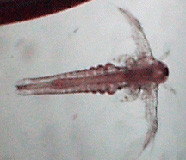
Crustacean metanauplius larva. (Photo: Dep.de formation des maitres. Physiologie animale, Universite Pierre & Marie Curie, Paris VI.)
|
metanauplius larva - postnaupliar larva of crustaceans with the same general body and limb morphology as the nauplius, but having additional appendages |
metanephridium - a type of excretory tubule in annelid worms. The metanephridium has internal openings called 'nephrostomes' that collect body fluids and conducts them to the outside through external openings, the 'nephridiopores' |
metanephros - the final excretory organ that develops in a vertebrate embryo. In birds, reptiles, and mammals it replaces the mesonephros as the functional excretory organ, and develops into the adult kidney |
metapopulation - a group of populations, usually of the same species, which exist at the same time but in different places. The dispersed population can replenish one another with migrants; a set of partially isolated conspecific populations which are able to exchange individuals and recolonize sites in which the species has recently become extinct |
metazoa - multicellular animals having cells differentiated into tissues and organs, and usually a digestive cavity and nervous system |
metecdysis - the final stage in arthropod molting in which the new cuticle is hardened |
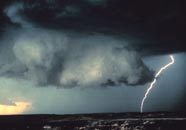
Meteorologists often study violent weather. (Photo: NOAA)
|
meteorology - the science that deals with atmospheric phenomena, especially weather and weather conditions |
meter - a unit of length which constitutes the basis of the Metric System. It is one ten-millionth part of the distance measured on a meridian of the Earth from the equator to the pole. One meter equals 39.37 inches |
methane - an odorless gas produced by the decomposition of organic matter |
methane hydrate - ice that contains a large amount of methane within its crystal structure. Methane hydrates are common constituents of the shallow marine geosphere, huge amounts of which underlie the oceans and polar permafrost. The methane is dominantly generated by bacterial degradation of organic matter in a low oxygen environment. There is an extraordinary amount of energy locked up in methane hydrate deposits, but no one has yet figured out how to extract the methane inexpensively. Methane is also a greenhouse gas and release of even a small percentage of total deposits could have a serious effect onthe Earth's atmosphere; also called "methane clathrate" and "methane ice" |
method - a description of how data and information are collected |
metric system - a decimal system of measures and weights with the meter and the gram as bases |
MHC (Major Histocompatibility Complex) - a complex family of genetically inherited proteins that play a critical role in immune response to foreign organisms. It is also involved in autoimmune disease and in transplant rejection. MHC are located on cell surfaces and work like receptors that interact with immune cells; molecules expressed on the surface of cells that identify the cell as being "self" vs "foreign". MHC molecules also bind foreign antigens and present them to the immune system |
microarray - in genomics, a tool for studying how large numbers of genes interact with each other and how a cell’s regulatory networks control vast batteries of genes simultaneously. A robot is used to precisely apply tiny droplets containing functional DNA to glass slides. Researchers then attach fluorescent labels to DNA from the cell they are studying. The labeled probes are allowed to bind to cDNA strands on the slides. The slides are put into a scanning microscope to measure how much of a specific DNA fragment is present |
microatoll - a circular colonial corallum up to 1 m height and 4 m diameter. Growth is mainly lateral, as upward growth is limited by aerial exposure |
microbe - a nonspecific term for small organisms that can be seen only with the aid of a microscope. The term encompasses viruses, bacteria, yeasts, molds,and protists. The term, however, is used most frequently in refererence to bacteria |
microbenthos (microfauna or microflora) - benthic organisms whose shortest dimension is less than 0.1 mm |
microbial loop - a micro-food chain that works within (or along side) the classical food chain. In the microbial loop the smallest organisms, the heterotrophic bacteria and picoplankton, use dissolved inorganic material directly as carbon and energy sources. These organisms are grazed upon by flagellates and ciliates. The flagellates and smaller phytoplankton are too small to be preyed on directly by copepods, long considered to be a major predator of microorganisms. Improved detection methods have demonstrated that ciliates provide an intermediate predator level in the microbial loop. These are then consumed by copepods and the process continues up the classical food chain (Marine Science Online) |
microbialite - an organosedimentary deposit formed from the interaction between benthic microorganism communities and sediments |
microbiology - the study of organisms that can be seen only with the aid of a microscope |
microbiota - organisms which are invisible, or nearly so, to the naked eye |
microclimate - the climate within a very small area or in a particular, often tightly defined, habitat |
Microdictyon - a genus of non-calcareous, fleshy green macroalgae which can form green mats or turf on the substrate; also an extinct "armored worm" known from the Early Cambrian Maotianshan shale of Yunnan, China |
microecology - the study of the interactions between microorganisms and their environment |
microenvironment - a specific set of physical, biological, and chemical factors immediately surrounding the organism |
microevolution - relatively minor change in the composition of a species' gene pool over time |
microfauna - animals which are invisible, or nearly so, to the naked eye |
microflora - plants which are invisible, or nearly so, to the naked eye |
microhabitat - a smaller part of a habitat that has some internal interactions allowing it to function self-sufficiently within a generally larger habitat, such as a patch reef in a lagoon |
micrometer - an instrument for measuring very small distances |
micron (µ) - a unit of length equivalent to a micrometer (µm), one-millionth of a meter or 0.00003937 inch |
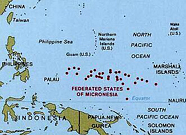
Map of Micronesia. (Graphic: U.S. CIA)
|
Micronesia - a region situated between the Mariana trench in the west and the Line Islands in the east. The name "Micronesia" means "tiny islands." the Federated States of Micronesia consists of the states of Yap, Chuuk, Pohnpei, and Kosrae. This region is composed of thousands of small islands, mostly atolls |
micronutrient - a nutrient, such as iron, copper, or zinc, that is required in very small amounts by plants in order to photosynthesize and thrive |
micropyle - the minute aperture in the egg membrane for the entry of the sperm cell |
microsatellites - loci (or regions within DNA sequences) where short sequences of DNA nucleotides are repeated in tandem arrays (the sequences are repeated one right after the other). The lengths of sequences used most often are di-, tri-, or tetra-nucleotides. In the literature they can also be called simple sequence repeats (SSR), short tandem repeats (Str), or variable number tandem repeats (VNtr). Microsastellites are inherited in a Mendelian fashion. They are widely used in the following applications: forensic identification and relatedness testing; diagnosis and identification of diseases; population studies (by looking at the variation of microsatellites in populations, inferences can be made about population structures and differences, genetic drift, genetic bottlenecks and even the date of a last common ancestor); and conservation biology where they can be used to detect sudden changes in population, effects of population fragmentation, and interaction of different populations. Microsatellites are useful in identification of new and incipient populations |
microsclere - a small spicule in sponges |
microsmatic - pertains to animals with a poorly developed olfactory (smell) sense |
microtidal - coastal ocean or waterway with a low mean tidal range, e.g., less than 2 meters |
microtubule - a long, hollow rod composed of the protein, tubulin. Microtubule networks make up portions of the cytoskeleton of all eukaryotic cells, aiding in cell structure and shape. They also function in intracellular transport of materials and organelles and are main components of cilia and flagella. Microtubules also participate in the formation of spindle fibers during cell division (mitosis) |
microvillus - any of the minute hairlike structures projecting from the surface of certain types of cells |
microwave - any electromagnetic radiation having a wavelength in the approximate range from one millimeter to one meter, the region between infrared and short-wave radio wavelengths |
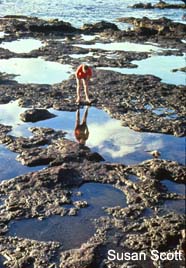
Tidal pools in the midlittoral zone. (Photo: Susan Scott)
|
midlittoral zone - the portion of the intertidal zone that is covered and uncovered by water each day |
midnight zone - the layer of the ocean beneath the twilight zone, extending from 1000-4000 meters. No light penetrates this zone; see "bathypelagic zone" |
midocean ridge - an uplifting of the ocean floor that occurs when convection currents beneath the ocean bed force magma up where two tectonic plates meet at a divergent boundary. The mid-ocean ridges of the world are connected and form a single global mid-oceanic ridge system that is part of every ocean and also by far the longest mountain range on Earth |
migrant - an animal that makes seasonal trips between breeding and non-breeding areas |

Humpback whales (Megaptera novaeangliae) migrate from near the poles to tropical waters. (Photo: R Wicklund)
|
migration - the large-scale movement of a population for some specific purpose |
milliammeter - an instrument for recording very small electrical currents |
millipore filter - a thin membrane composed of cellulose fibers that is used, for example, as a filter in the bacteriological examination of water |
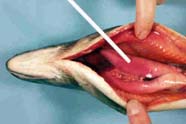
The testes of this male adult salmon produce milt when ready to spawn. The milt becomes a liquid, containing sperm cells, and exits through the vent opening to fertilize eggs. (Photo: Pacific Streamkeepers Federation)
|
milt - the testes of fishes when filled with semen; fish seminal fluid |
mimicry - the appearance or characteristics of one organism that copies or "mimics" another in order to gain some advantage; the organism may resemble some other natural object as an aid in concealment |
Minamata disease - mercury poisoning of humans from eating contaminated seafood |
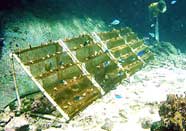
This effective method of growing corals with electricity,currently used in worldwide research and holds high potential for restoring coral reefs damaged by causes of reef destruction(Photo:Great Barrier Reef Marine Park Authority)
|
mineral accretion - a technique used to grow corals on artificial reefs using electricity to accrete minerals thereby cementing coral colonies to the substrate. Applying a low voltage to a metallic structure causes calcium carbonate (CaCO3) to build on the metal, upon which coral larvae can attach, settle and feed. This greatly speeds the coral reef growth process. The voltage is low enough that it can easily be generated by floating solar panels or from wave action |
mineral deposit - an accumulation of naturally occurring minerals |
mineralization - the process in which organic compounds (e.g., dead plant or animal materials) are converted to inorganic compounds |
mini-atoll - a ring-shaped patch reef with a central area (lagoon) containing sand |
minimum viable population (mvp) - the smallest isolated population having a good chance of remaining extant for a given number of years despite the foreseeable effects of demographic, environmental, and random genetic events and natural catastrophes |
minisatellites - segments of repeated DNA often used as genetic markers for individual identification |
Minor Outlying Islands - United States Minor Outlying Islands are: Baker Island, Howland Island, Jarvis Island, Johnston Atoll, Kingman Reef, Midway Islands, Wake Island, Palmyra Atoll, and Navassa Island (disputed with Haiti) |
misspelling - in zoological nomenclature, a citation of a name in the literature that is incorrectly spelled |
mitigation - the act of making less severe or intense; measures taken to reduce adverse impacts on the environment |
mitigation plan - a proposal to reduce or alleviate potentially harmful impacts |
mitochondrial DNA (mtDNA) - DNA that is located in the mitochondria of cells. Mitochondrial DNA is maternally inherited and is a powerful tool for tracking matrilineage |
mitochondrial genome - the genetic material of the mitochondria. It is similar in structure to that of the prokaryotic genetic material, formed of a single circular DNA molecule. The mitochondria of sexually-reproducing animals usually comes only from the maternal side, and is essentially the same as that of the mother. Sometimes mitochondria from spermatozoa are also passed on to offspring. Mitochondrial DNA has been studied to trace lineage far back in time |
mitochondrial RNA (mtrNA) - RNA that is located in the mitochondria of cells |
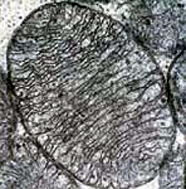
Electron micrograph of a single mitochondrion showing the organized arrangement of the protein matrix and the inner mitochondrial membranes. (Photo: U.S. Dept. of Health and Human Services/National Institutes of Health)
|
mitochondrion - an organelle found in the cells of most eukaryotes. Mitochondria are sometimes described as cellular "power plants" because their primary function is to manufacture adenosine triphosphate (ATP), which is used as a major source of cellular energy |
mitogen - any substance that causes cells to begin dividing by mitosis |
mitosis - the process of nuclear division in eukaryotic cells that produces two daughter cells from one mother cell, all of which are genetically identical to each other. See cell division - |
mitotic spindle - a network of fiber-like microtubules that forms in a cell's nucleus during mitosis (nuclear division) which connects the centrosomes to the kinetochores and helps move the chromosomes around |
mixed layer - near-surface waters subject to mixing by the action of wind and waves. There is little variation in salinity or temperature at depths below the mixed layer |
mixed zone - the populous region of most bank/barrier reefs seaward of the lower palmata zone. It begins at a depth of 6-8 m |
MJO (Madden Julian Oscillation) - a major perturbation of tropical convection which moves and completes a global circuit every 30 to 60 days. It is a dominant cause of intraseasonal variability in tropical equatorial regions |
MLCD (Marine Life Conservation District) - a designated area for the conservation and replenishment of marine resources. MLCDs allow only limited fishing and other consumptive uses, or prohibit such uses entirely. They provide fishes and other aquatic life with a protected area in which to grow and reproduce, and are home to a great variety of species |
MMM (Maximum Monthly Mean SST climatology) - the highest expected (climatological) monthly SST expected at all ocean locations based on 15 years of monthly mean SST data (serves as the input threshold for the Coral Bleaching HotSpot charts) |
mode - a statistical measure of central tendency. The number that appears most in a sequence of numbers. A list of numbers can have more than one mode |
model - a mathematical approximation or simulation of a real system, process, or object that omits all but the most essential variables, developed to understand its behavior or to make predictions |
Modern Synthesis - the synthesis of natural selection and mendelian inheritance |
modifier gene - a gene that modifies the effect produced by another gene |
moiety - a component part of a complex molecule |
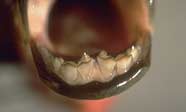
The teeth of this fish (Colossoma nigripinnis) are molar-like. Although they may have cusps, they are designed to crush food materials (Photo: Florida Fish and Wildlife Commission)
|
molar - a large flat or ridged-topped tooth adapted for crushing or grinding |
molar solution - an aqueous solution that contains one mole (gram-molecular weight) of solute per liter |
molariform - shaped like a molar tooth, being rounded and flattened. In fishes, molariform teeth are used for crushing mollusks and crustaceans |
mole - the mass of a compound in grams numerically equal to its molecular weight. Also, the mass of a compound containing Avogadro’s number of molecules |
molecular biology - a branch of biology that studies the biology of a cell at the molecular level. Molecular biological studies are directed at studying the structure and function of biological macromolecules and the relationship of their functioning to the structure of a cell and its internal components. Great attention is given to genetic aspects such as replication, transcription and translation |
molecular clock - a technique in genetics, based on the molecular clock hypothesis (MCH), which is used to date when two species diverged. It deduces elapsed time from the number of minor differences between their DNA sequences |
molecular clock hypothesis (MCH) - the principle that any gene or protein has a near-constant rate of evolution in all branches of a clade, which means that the amount of sequence divergence between two sequences will be proportional to the amount of time elapsed since their shared ancestor existed |
molecular evolution - the process of evolution at the scale of nucleic acids (DNA and RNA) and proteins |
molecular genetics - the study of how genes function to control cellular activities |
molecular phylogeny - the use of the structure of molecules to gain information on an organism's evolutionary relationships. The result of a molecular phylogenetic analysis is expressed in a phylogenetic tree |
molecular systematics - the process of using data on the molecular constitution of of organisms' DNA and/or RNA (nucleotide sequencing) in order to resolve questions in systematics and phylogeny |
molecular weight - the sum of the atomic weights of the atoms in a molecule |
molecule - a small particle composed of two or more atoms. Molecules are a stable configuration of atomic nuclei and electrons bound together by electrostatic and electromagnetic forces. They have characteristic physical and chemical properties, different from the atoms of which they are composed |

Atlantic deer cowrie (Cypraea cervus) grazing in the Flower Garden Banks National Marine Sanctuary. (Photo: Frank and Joyce Burek)
|
Mollusca - an animal phylum that includes bivalves, squids, octopuses and snails. They are distinguished by a muscular foot, a calcareous shell secreted by the underlying body wall (the mantle) and a feeding organ (the radula). Many species are common inhabitants of coral reefs |
molt - to shed part or all of a coat or outer covering, such as, shell, feathers, cuticle or skin, which is replaced periodically by a new growth |
monaxon - a linear spicule in sponges; a single rod or ray with a pointed, hooked, or knobbed end |
Monera - the Kingdom composed of prokaryotic organisms. They have a cell wall, and lack both membrane-bound organelles and multicellular forms. The Archaebacteria, the most ancient of this Kingdom, are so different that they may belong to a separate kingdom. Monera include the cyanobacteria and eubacteria |
moniliform - contracted at short, regular intervals like a string of beads; bead-like |
monitoring - the systematic collection of data over time |

A Hawaiian monk seal foraging on a coral reef in the Northwestern Hawaiian islands. (Photo: NOAA/NMFS)
|
monk seal - an endangered species of seal (Monachus schauinslandi) normally found on the leeward (southwest) sides of the Northwestern Hawaiian Islands, and occasionally sighted in the Main Hawaiian Islands. It is estimated that fewer than 1500 Hawaiian monk seals exist today. The Hawaiian monk seal was officially designated endangered 1976 and is protected by the Endangered Species Act and the Marine Mammal Protection Act. It is illegal to kill, capture or harass monk seals. A critically endangered species of monk seal (Monachus monachus) is found in the Mediterranean Sea. The Caribbean monk seal (Monachus tropicalis) is thought to be extinct |
mono- - a prefix meaning one |
monocarpic - refers to plants that flower and bear fruit only once; semelparous |
monoecious - having combined sexes. Individuals of monoecious species contain the reproductive systems of both males and females |
monofilament - a single large filament or threadlike structure of a synthetic fiber, such as a monofilament fishing line |
monogamy - a male and a female mating only with each other |
monomer - in chemistry, a single molecule that is the subunit of a polymer; in genetics, a character determined by a gene or genes at a particular locus |
monomorphic - occurring in only one form |
monopectinate gill (ctenidium) - in mollusks, refers to having gill lamellae on one side of the ctenidial axis |
monophagous - eating one kind of food only |
monophyletic group - a group of organisms descended from a common ancestor |
monopodial growth - growth of a coral colony in which the trunk of the colony is made by the oldest polyp. The trunk grows during growth of new polyps. The oldest polyp is always on top of the colony |
monosaccharide - a sugar that does not hydrolyse to produce other sugars; the simplest group of carbohydrates |
monotype - in taxonomy, a situation where a genus group taxon is established with only one immediately subordinate taxon, e.g., a genus containing only one species |
monsoon - a periodic wind caused by the effects of differential heating, with the largest being the Indian monsoon found in the Indian Ocean and southern Asia |
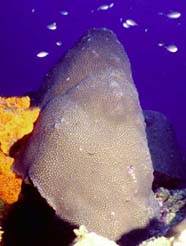
Great star coral (Montastraea cavernosa) is one of four species of Montastraea found at the Flower Garden Banks in the Gulf of Mexico. (Photo: Dr. Stephen Gittings)
|
Montastraea - a genus of hard (stony) coral that includes the boulder coral and the great star coral |
montiform - mountain-shaped |
Montreal Protocol on Substances that Deplete the Ozone Layer - an international treaty designed to protect the ozone layer by phasing out the production of a number of substances believed to be responsible for ozone depletion |
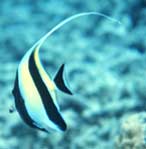
A Moorish Idol (Zanclus cornutus) on an Indopacific reef (Photo: NOAA)
|
moorish idol - a bony fish species (Zanclus cornutus) in the family Zanclidae. The moorish idol is the only species in the family. It has a long, white, sickle-shaped dorsal fin, two broad vertical black bars on the body, and a yellow-orange saddle across the s |
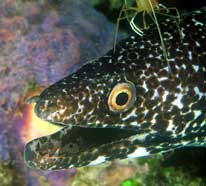
A spotted moray (Gymnothorax moringa) with a cleaning shrimp (Lysmata grabhami) (Photo:Tom Doeppner, Ph.D./ Brown University)
|
moray eel - any of numerous chiefly tropical, brightly colored marine eels of the family Muraenidae that commonly inhabit coral reefs |
morbidity - illness or disease; the incidence and prevalence of a specific disease |
morgan - unit of inferred distance between genes on a chromosome |
morph - a distinct genetic form or variant of a particular species. For example, a distinct color phase of a species that exhibits more than one color; a specific form, shape, or structure |
morphogenesis - a change in the shape or structure of an organism through growth and differentiation |
morphological species - a typological species distinguished solely on the basis of morphology; also called "morphospecies" |
morphology - a branch of biology that deals with the form and structure of organisms, apart from their functions (physiology) |
morphometric character - a measurement of a body part, e.g., head length or eye diameter |
morphospecies - the traditional way to distinguish one species from another is to use differences in morphology which could involve size, shape, body part proportions, or color of external and/or internal body structures. Species named in this way may be referred to as "morphospecies." Different morphospecies, however, may not conform to the usual definition of a biological species. Many geographically isolated morphospecies that are viewed as being closely related may be just genetic varieties within a species |
mortality - the death rate; the ratio of the total number of deaths to the population of a specified area in a given time period |
morula - a stage of embryonic development in which the cleaving cells (blastomeres) appear as a cluster of blastomeres without a cavity; precedes the blastula stage of embryonic development |
mosaic evolution - the evolution of different characters within a lineage or clade at different rates, hence more or less independently of one another |
mosaic teeth - the series of rows of flat teeth found in rays,skates and some sharks. They are used for crushing hard foods as mollusks and crustaceans; also called "pavement teeth" |
motile - capable of self-locomotion in organisms |
motu - a coral island in the lagoon of an atoll |
MOU (Memorandum of Understanding) - an interagency agreement defining the role and responsibility which each agency has in dealing with particular issues |
mound - an elongate offshore ridge of unconsolidated substrate; rocky remnants of eroding headlands (bars; shallow masses of limestone deposited by corals and coralline algae (shallow reefs) |
mouth brooder (oral brooder) - a fish which broods or protects the eggs or young by taking them into the mouth cavity |
mouthparts - a collective term for the appendages around the mouth of crustaceans which are concerned with feeding: mandibles, maxillae and maxillipeds |
MPRSA (Marine Protection, Research, and Sanctuaries Act) - the MPRSA (1972) provides protection for many coral reefs by authorizing NOAA to designate areas as marine sanctuaries and promulgate regulations for the conservation and management of those areas. Since the Act was passed, thirteen sanctuaries have been designated, several of which contain coral reef communities. Coral research, monitoring, and management activities are conducted in these sanctuaries, as well as in the Northwestern Hawaiian Islands Coral Reef Ecosystem Reserve, which is currently (June 2004) under consideration to become the nation’s fourteenth sanctuary |
mRNA (messenger RNA) - an RNA molecule that encodes the amino acid sequence of a protein. It is the mediating template between DNA and proteins. The encoded information from a particular gene is transferred from a strand of DNA by the construction of a complementary template strand of RNA (mRNA) through the transcription process. Next, three nucleotide segments of RNA, called trNA (transfer RNA), which are attached to specific amino acids, match up with the template strand of mRNA to order the correct sequence of amino acids. These amino acids are then bonded together to form a protein a in a process, called translation. translation occurs in the ribosomes, which are composed of proteins and a third kind of RNA, rRNA (ribosomal RNA) |
MSS (Multispectral Scanner) - a scanner system that simultaneously acquires images of the same scene in various wavelength bands |
muciferous - producing or containing mucus |
mucocyte - a mucus-secreting cell |
mucophagy - feeding on the mucus of fishes or invertebrates |
mucus - a gelatinous material secreted by specialized mucous cells. In corals, it functions in protection from bacterial invasion, food capture, and removal of sediment particles. Mucus is usually moved by cilia (motile hair-like extensions of the cell membrane) |
mucus cell - a cell which secretes mucin, which, when mixed with water forms mucus |
mud - a fine sediment often associated with river discharge and buildup of organic material in areas sheltered from high-energy waves and currents |
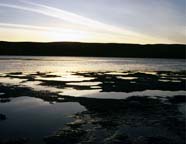
Nutrient-rich mudflats at the Gulf of the Farallones National Marine Sanctuary in California. (Photo: Dan Howard)
|
mud flat - a relatively level area of fine silt along a shore (as in a sheltered estuary) or around an island, alternately covered and uncovered by the tide, or covered by shallow water |
mud mound - accumulations of biogenic carbonate sediment that are common in the geological record; carbonate mud-dominated deposits with topographic relief and few or no stromatolites, thrombolites or in place skeletons; carbonate mud mounds can be organic and/or inorganic in origin |
Muller's ratchet - a term given to the process by which the genomes of an asexually reproducing population accumulate deleterious mutations in an irreversible manner because of the lack of genetic recombination |
Mullerian mimicry - a form of protective mimicry in which noxious species evolve through convergent evolution to resemble each other |
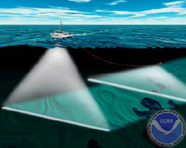
Hull-mounted multibeam sonar (left) and towed side scan sonar (right) (Graphic: NOAA)
|
multibeam sonar - sonar signals arriving at a target, or the towfish, from a single source but along different paths. The multibeam sonar system consist of a transducer, motion sensor, gyrocompass, and navigation system. When collected in slightly overlapping swaths (fanlike coverages from sonar scans), multibeam sonars can produce a sonar data set that represents nearly 100 percent acoustic coverage of the seafloor |
multicellular - refers to organisms that are made up of more than one cell. Multicellular organisms have differentiated cells that perform specialized functions |
multienzyme - a protein possessing more than one catalytic function contributed by distinct parts of a polypeptide chain, or by distinct subunits, or both |
multimedia - the use of computers to present video, sound, graphics, and text |
multimodal distribution - a distribution with more than one mode |
multiple use MPA - often employed over larger areas, multiple-use areas allow for integrated management of complete marine ecosystems, usually through a zoning process |
multispecies fish spawning aggregation - a fish spawning aggregation containing multiple species spawning in the same area over time |
multivariate - a term that describes statistical, mathematical, or graphical procedures that involves two or more variables simultaneously |
multivariate analysis of variance - an analysis of variance with two or more dependent variables |
multivariate community analyses - statistical methods for analyzing physical and biological community data using multiple variables |
municipal discharge - discharge of effluent from waste water treatment plants, which receive waste water from households, commercial establishments, and industries in the coastal drainage basin |
municipal Sewage - wastes (mostly liquid) originating from a community; may be composed of domestic wastewaters and/or industrial discharges |
muon - a charged lepton about 200 times more massive than an electron; an elementary particle with a negative charge and a half-life of 2 microsecond; decays to electron and neutrino, and antineutrino |
mutagen - an agent that causes a permanent genetic change in a cell other than that which occurs during normal genetic recombination |
mutation - changes in the nature of single genes or segments of chromosomes, which are then inherited by successive generations |
muton - the smallest mutable site within a cistron; the smallest part of a gene ( a single nucleotide pair) that can be involved in a mutation event |
mutualism - a symbiotic interaction between two species in which both derive some benefit |
MYA - an acronym for "million years ago" |
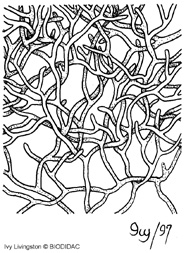
Drawing of the mycelium of a fungus. (Photo: Jon Houseman\BIODIDAC)
|
mycelium - the mass of filamentous growth (hyphae) from which the vegetative part of a fungus develops |
mycobacteriosis - in fishes, mycobacteriosis is a disease caused by bacteria within the genus Mycobacterium. There are many different species of Mycobacterium that also cause diseases in birds, reptiles, and mammals. Some also cause important diseases in humans. the Mycobacterim species in fishes are referred to as non-tuberculous mycobacteria and do not cause major disease in healthy humans. However, while rare, transmission from infected fishes to humans is possible and may cause a skin infection referred to as "fish handler's disease" or "fish tank granuloma" |
mycophage - an animal which primarily eats fungi |
mycosis - any disease caused by a fungus |
myocin - one of two proteins responsible for muscle cell contraction (the other is the globular protein, actin). Myosin bundles intermesh with actin bundles, and contraction occurs when the two protein bundles slide over each other |
myoepithelial cell - a contractile cell in cnidarians |
myoglobin - an oxygen-binding protein found in the muscle cells of animals. It functions as an oxygen storage unit, providing oxygen to the muscles. Diving marine mammals, such as seals and whales are able to remain submerged for long periods because they have greater amounts of myoglobin in their muscles than other animals do. There is a close chemical similarity between myoglobin and hemoglobin, the oxygen-binding protein of red blood cells |
myoneme - a contractile fibril found in the cytoplasm of certain protozoans; a contractle fibril of epitheliomuscular cells of anthozoans |
myotome - any segment of embryonic mesoderm that develops into skeletal (voluntary) muscle in the adult; any of the segmentally arranged blocks of muscle in lower vertebrates, such as fishes |
mytiliform - in the shape of the mussel shell (genus Mytilus) |
myxopterygium (clasper) - the copulatory organ or clasper of sharks, rays, skates and chimaeras |
|
|
|
|

